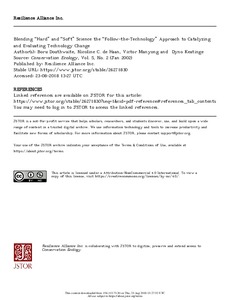| dc.contributor.author | Douthwaite, Boru |
| dc.contributor.author | Haan, N. de |
| dc.contributor.author | Manyong, Victor M. |
| dc.contributor.author | Keatinge, J.D.H. |
| dc.date.accessioned | 2019-12-04T11:24:21Z |
| dc.date.available | 2019-12-04T11:24:21Z |
| dc.date.issued | 2002-01 |
| dc.identifier.citation | Douthwaite, B., De Haan, N.C., Manyong, V. & Keatinge, D. (2002). Blending “hard” and “soft” science: the “follow-the-technology” approach to catalyzing and evaluating technology change. Conservation Ecology, 5(2), 1-12. |
| dc.identifier.uri | https://hdl.handle.net/20.500.12478/4350 |
| dc.description | Published online: 20 Dec 2001 |
| dc.description.abstract | The types of technology change catalyzed by research interventions in integrated natural resource management (INRM) are likely to require much more social negotiation and adaptation than are changes related to plant breeding, the dominant discipline within the system of the Consultative Group on International Agricultural Research (CGIAR). Conceptual models for developing and delivering high-yielding varieties have proven inadequate for delivering natural resource management (NRM) technologies that are adopted in farmers' fields. Successful INRM requires tools and approaches that can blend the technical with the social, so that people from different disciplines and social backgrounds can effectively work and communicate with each other. This paper
develops the "follow-the-technology" (FTT) approach to catalyzing, managing, and evaluating rural technology change as a framework that both "hard" and "soft" scientists can work with. To deal with complexity, INRM needs ways of working that are adaptive and flexible. The FTT approach uses technology as the entry point into a complex situation to determine what is important. In this way, it narrows the research arena to achievable boundaries. The methodology can also be used to catalyze technology change, both within and outside agriculture. The FTT approach can make it possible to channel the innovative potential of local people that is necessary in INRM to "scale up" from the pilot site to the landscape. The FTT approach is built on an analogy between technology change and Darwinian evolution, specifically between "learning selection" and natural selection. In learning selection, stakeholders experiment with a new technology and carry out the evolutionary roles of novelty generation, selection, and promulgation. The motivation to participate is a "plausible promise" made by the R&D team to solve a real farming problem. Case studies are presented from a spectrum of technologies to show that repeated learning selection cycles can result in an improvement in the performance of the plausible promise through adaptation and a sense of ownership by the stakeholders. |
| dc.format.extent | 1-12 |
| dc.language.iso | en |
| dc.subject | Technology |
| dc.subject | Approaches |
| dc.subject | Natural Resources Management |
| dc.subject | Evolution |
| dc.title | Blending hard and soft science: the Follow the Technology approach to analyzing and evaluating technology change |
| dc.type | Journal Article |
| dc.description.version | Peer Review |
| cg.contributor.crp | Agriculture for Nutrition and Health |
| cg.contributor.crp | Policies, Institutions and Markets |
| cg.contributor.affiliation | International Institute of Tropical Agriculture |
| cg.coverage.region | Africa |
| cg.coverage.region | East Africa |
| cg.coverage.country | Tanzania |
| cg.creator.identifier | Nicoline de Haan: 0000-0002-6392-7079 |
| cg.creator.identifier | Victor Manyong: 0000-0003-2477-7132 |
| cg.identifier.url | http://www.consecol.org/vol5/iss2/art13/ |
| cg.authorship.types | CGIAR single centre |
| cg.iitasubject | Agribusiness |
| cg.journal | Conservation Ecology |
| cg.howpublished | Formally Published |
| cg.accessibilitystatus | Open Access |
| local.dspaceid | 100009 |
| cg.targetaudience | Scientists |

